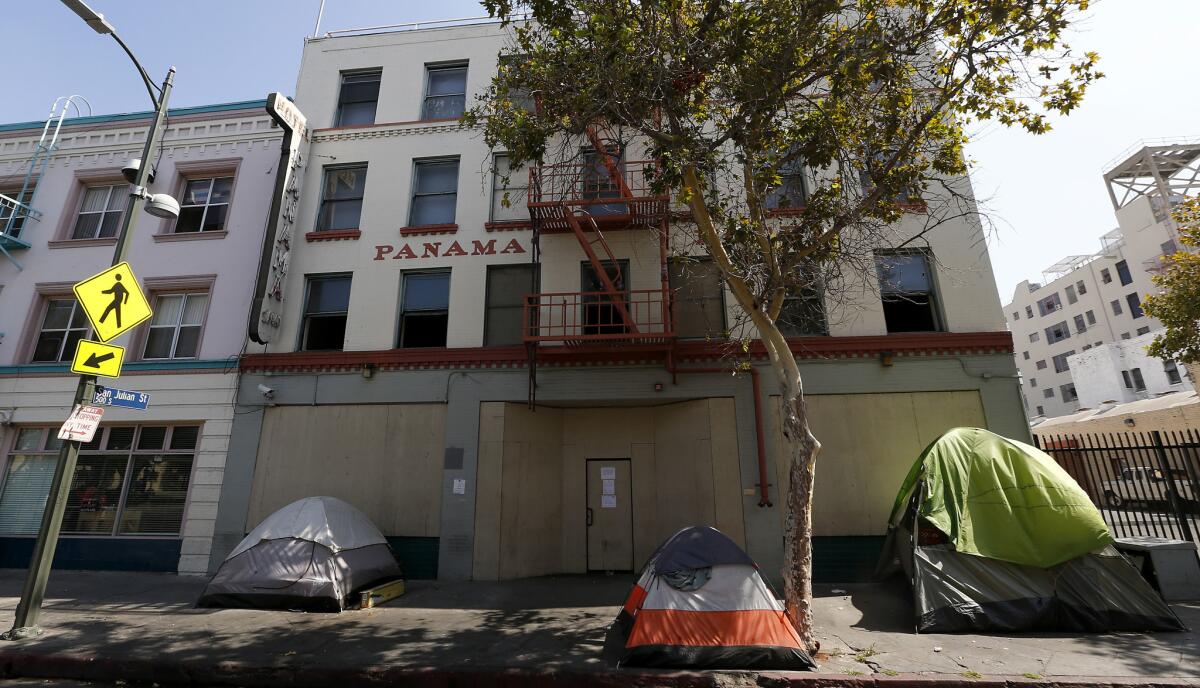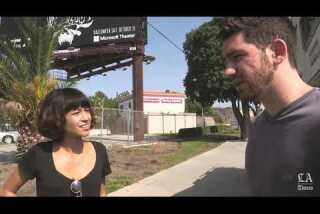Is the shift to permanent housing making L.A.’s homelessness problem even worse?

- Share via
As Los Angeles grapples with the nation’s worst homelessness problem, experts have almost universally embraced permanent housing as the best approach for lifting people out of homelessness.
The strategy is to quickly re-house those who are able to live independently, and to provide housing with intensive on-site services for chronically homeless people for as long as it takes them to become independent, or for life if needed.
But the shift toward permanent housing has had a cost: As money has been directed away from programs that combine services with shorter-term housing, the region’s homelessness problem has gotten worse.
The county’s overall homeless population was roughly unchanged from 2015 to 2016. But the “unsheltered population” — those literally living on the street — increased by about 1,400, according to the Los Angeles Homeless Services Authority’s annual count.
The homeless authority attributed the increase at least in part to the loss of beds in programs that were converted to permanent housing or had their funding cut.
See the most-read stories this hour »

A prime example of the policy shift and its impact is the Panama Hotel, which for decades offered refuge for men and women trying to get off L.A.’s skid row.
Tenants could stay in the hotel’s 220 rooms for up to 90 days while getting their lives together with support from the therapists and case managers of SRO Housing Corp., a nonprofit that owns the hotel.
But the Panama, on 4th Street, is empty. It has been gutted for remodeling and will reopen next year as permanent supportive housing — but with just 72 units. More than 200 people had to move out for the makeover.
“We tried to transition as many as we could and farm out to other agencies,” said Chief Executive Anita Nelson. “Unfortunately, some people went back on the street.”
For years, a growing number of homeless services organizations have been backing off of “transitional” housing — service-backed programs of up to two years designed to prepare people for permanent housing.
The rationale is that some people — especially those who become homeless because of an economic crisis — need only access to housing, not a long period of support. On the other hand, a high proportion of the chronically homeless are so severely impaired that short-term programs only lead them through a cycle of relapse.
It always bothers me that they don’t fund transitional because they don’t believe in it.
— Kevin Murray, president and chief executive of the Weingart Center
The U.S. Department of Housing and Urban Development has adopted that philosophy and is shifting money to permanent housing with a quick turnaround for those who are ready, and open-ended support for those who need it.
In turn, the homeless authority, which competes for HUD money to pass on to local agencies, is requiring longstanding programs to drop their transitional housing.
Last year the authority cut the funding for about 2,000 beds of transitional housing operated by 58 agencies.
This year more cuts are on the way.
In an email, a spokesman for the homeless authority said it supports the federal policy and believes the reallocation of grants will serve more people and better distribute resources.
HUD spokesman Brian Sullivan said the federal agency was acting on research showing that the added services with transitional housing are not cost-effective.
“While transitional housing can be an important tool in managing homelessness, we’re encouraging communities to offer permanent housing solutions to an even greater number of persons and families who are experiencing homelessness,“ Sullivan said.
The change is welcomed by organizations such as PATH, a statewide agency that provides housing, outreach and supportive services at several locations in Los Angeles.
“Our organization is focused on permanent housing outcomes,” said communications director Jeremy Sidell. “We’ve always believed the only way to end homelessness is to put people in homes.”
The problem for the thousands of homeless people who need both housing and services is that the permanent housing that will replace transitional beds doesn’t exist today and won’t for years.
According to Carlos Vannatter of the L.A. city Housing Authority, a handful of nonprofit development companies currently build about 300 units of permanent supportive housing in the city of Los Angeles each year — units that are filled as soon as they open.
That pace could triple if Los Angeles voters approve a $1.2-billion bond in November. But the first apartments funded by the new money, if the bond passes, would open years from now.
In the meantime, agencies are reeling from the immediate loss, especially smaller ones, such as the California Council for Veterans Affairs, which provides free housing to homeless female veterans.
“I had to cut staff,” said the council’s director, Margaret Bush-Ware. “I had to cut beds.”
Her two social workers, one licensed to distribute medication, are gone.
Since January, the agency has stopped taking new clients, Bush-Ware said. It now has seven empty beds out of 14 in its three-unit apartment building on Florence Avenue.
Proponents of permanent supportive housing cite research such as that by Dennis P. Culhane of the University of Pennsylvania concluding that limited-term housing with clinical support isn’t the best response for housing emergencies and is inadequate for the chronically homeless population.
Not all providers, however, are on board with the new model.
“It always bothers me that they don’t fund transitional because they don’t believe in it,” said Kevin Murray, president and chief executive of the Weingart Center on skid row. The agency has lost 300 transitional units to defunding over five years, according to homeless authority data.
“We believe in the transitional model,” Murray said. “We believe that there is a whole class of people out on the streets that can be made to be self-sufficient.”
Nelson, the SRO Housing head, said her agency’s model has always been to have as much housing as possible, including emergency shelter, transitional and permanent.
“We tried to keep our doors open because we saw the tremendous need,” Nelson said. “We ended up losing hundreds of thousands of dollars in doing so.”
The complete video series about homelessness


On the Streets: 'On the Streets' Documentary Trailer

On the Streets: Skid Row: Not the last stop

On the Streets: Living on Venice Boulevard

On the Streets: Moving out of Skid Row

On the Streets: Squeezed in on all sides

On the Streets: One homeless woman's hustle outside the world's largest jail

On the Streets: Young and homeless in Hollywood

On the Streets: He is getting his PhD - and is homeless

On the Streets: Join an L.A. police officer on his skid row beat

On the Streets: Slab City: A haven for the homeless gentrifies
Agencies that lose their transitional funds have other options. But they say the transition isn’t smooth.
After its grant was cut this year, the House of Ruth in Boyle Heights was offered the chance to compete for a new grant in September.
The grant-cutting news came in April and was effective immediately, said Sister Jennifer Gaeta, the executive director.
“I just about went crazy,” she said. “That is going to close us.”
House of Ruth owns four houses with a total of 16 bedrooms and serves up to 80 single mothers and their children.
As soon as Gaeta got the notice, she stopped accepting new clients. Now four bedrooms are empty.
Even if she can persevere to September and get the new funding, she’ll have to lay off at least six of her 17 employees, she said.
And the money will come with strings: two houses will be converted to permanent housing, cutting the agency’s total bed count in half. The other two houses will be used for crisis housing — sometimes called bridge or rapid re-housing — with stays lasting a maximum of 90 days.
That may work for some, but it is too short for victims of domestic abuse.
“It takes a lot of time to level out,” Gaeta said.
She’s also not pleased that she’ll be asked to serve more chronically homeless individuals and fewer families in crisis.
“We’ve got all these young moms hiding in cars and being forgotten,” Gaeta said. “If we put all our funding into the chronically homeless, all we are doing is creating a new generation of chronically homeless.”
Twitter: LATdoug
Times staff writer Christine Zhang contributed to this report.
ALSO
What police are doing right (and wrong) with the homeless in downtown L.A.
He was homeless — but to get help, the rules said he had to prove it
Skid row street-corner minister calls for homeless state of emergency declaration
In Westlake, homeless people take cues from immigrant street vendors
More to Read
Sign up for Essential California
The most important California stories and recommendations in your inbox every morning.
You may occasionally receive promotional content from the Los Angeles Times.














